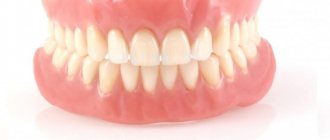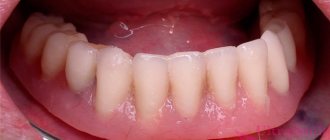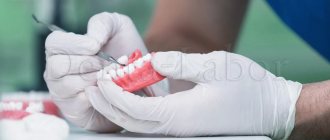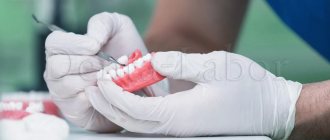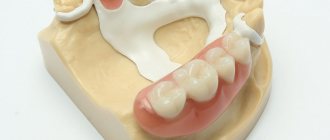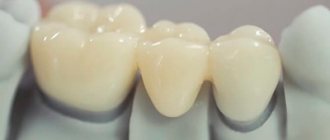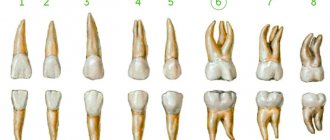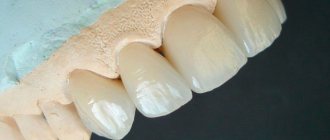1002
Biologically passive thermoplastics of medical purity are increasingly being used for the manufacture of artificial organs and individual body structures.
The most famous and most popular thermoplastic for creating the basis for removable dentures is polyamide, patented under the Deflex brand.
Polyamide is developed by the Argentine company NUTEN as a material for the manufacture of the base of removable structures.
Features of the material
Deflex is a polyamide with a high elasticity index, which allows this material to be classified as a semi-rigid thermoplastic.
This feature gives polyamide significant advantages, and puts prostheses based on it an order of magnitude higher than nylon analogues in many characteristics.
Thus, the material has increased temperature stability , and reacts completely differently to temperature changes. Deflex, as is usually the case with nylon, does not harden when eating cold foods and does not soften when eating hot foods.
The simultaneous combination of the maximum density of polyamide with its minimum porosity provides high levels of strength, stability and durability of prosthetic products based on it.
And the low absorption of all kinds of liquids blocks the formation and fixation of bacterial plaque on the surface , the appearance of odor, and prevents distortion of the color of the structure.
The increased strength and elasticity of the material makes it possible to make a device whose thickness will be at least half that of acrylic, which guarantees it comfort when wearing, lightness, and preservation of the patient’s natural phonetics.
In addition, with such characteristics it was possible to distribute the chewing load evenly, prevent the formation of a shoulder load on the supporting elements and ensure the vertical stability of the entire structure.
Polyamide is a hypoallergenic material , which means it is ideal for patients who are prone to all kinds of allergic manifestations. Deflex is also distinguished by its natural transparency, which makes products based on it completely invisible.
Important! A unique combination of creation technology and material allows us to produce a functional prosthesis with ideal aesthetics. Such products comply with the Kennedy classification, combining 5 main functional properties - stability, support, retention, bending and occlusion.
The first signs of an allergy to dentures and ways to get rid of the problem.
Visit here to learn more about contraindications for removable dentures.
At this address https://www.vash-dentist.ru/protezirovanie/semnyie-p/vidyi-klammerov.html we will consider the types of retaining clasps.
Pros and cons of nylon prostheses
Medical nylon dentures are lightweight and comfortable designs that are used both for complete and partial loss of teeth. They are strong, relatively durable, aesthetically pleasing - almost invisible to others, and make it possible to completely restore chewing function. Such prosthetics can be used if the budget is limited or implantation is not possible for medical reasons.
But it has a number of disadvantages:
- not a particularly reliable fastening, even the highest quality system “looses” over time;
- requires regular hygiene - cleaning;
- systems are significant in size;
- The term of use of a removable denture is up to 5 years.
Areas of use
The area of use of polyamide prostheses is quite wide. It is appropriate to install such products in patients with the following indications:
- minor defects in the dentition, when 1-2 elements are missing;
- edentia, i.e. not a single tooth survived;
- allergic reaction to metal alloys.
Deflex dentures are also successfully used for patients suffering from periodontal disease or periodontitis, since there are no conditions for loosening of supporting teeth.
It is also advisable to recommend them to those for whom preparation is strictly contraindicated.
Polyamide structures are ideal for people who have traumatic professions, for example, firefighters, police officers, athletes, etc., since it is almost impossible to break them.
It is also recommended to choose Deflex for people who, due to certain restrictions, are contraindicated for implantation.
Such pathological conditions include:
- heart failure;
- thyroid problems;
- immune system diseases;
- hepatitis;
- diabetes;
- blood diseases.
In what cases is it used?
Polyamide prostheses are installed, as a rule, in the following cases:
- metal alloys cause an allergic reaction;
- Several elements are missing;
- edentulism;
- with restrictions on implantation, for example, with diseases of the heart, blood, immune system, and diabetes.
Deflex is installed in cases where the patient suffers from periodontitis or periodontal disease.
Polyamide prostheses are successfully used in individuals at high risk of injury, such as firefighters, athletes or police officers. It is impossible to break such a structure.
Contraindications
Important! Removable devices, including polyamide ones, have virtually no contraindications for use.
They should not be worn by people suffering from:
- pathologies of bone tissue;
- mental disorders;
- oncology;
- acute or chronic inflammatory diseases in the body.
It is also not recommended to install them if you are depressed, pregnant, drug addicted, or undergoing radiation therapy.
Why dentures may become loose and what specialists are doing.
In this publication you will find detailed information on the adequate selection of abutment teeth.
Here https://www.vash-dentist.ru/protezirovanie/semnyie-p/raznovidnosti-bazisov-zubnyih.html all the most important things about creating the basis of a partial removable denture.
Types of designs
Specialists from dental laboratories note that a huge number of orthopedic products can be manufactured using Vertex Thermosens:
- fully and partially removable devices;
- crowns;
- bridge structures;
- occlusal splints;
- overdentures on implants;
- dental splints;
- individual structural elements for products.
Most often, Vertex Thermosens material is used for the production of complete, partially removable and conditionally removable structures.
Full removable
The design is used when it is necessary to restore all elements of the jaw row, where the hard palate and alveolar process act as support. The product is completely removable and requires regular removal from the mouth for thorough hygiene.
Among the advantages of complete removable structures are their versatility, aesthetics, lightness, and high speed of adaptation.
The disadvantages of the products include instability due to the lack of supporting teeth and a high load on the tissues of the oral cavity.
Complete dentures are usually made from acrylic material, which is wear-resistant and durable, but has many disadvantages.
Partially removable
The main indication for the use of this type of orthopedic design is the need to restore missing elements of the jaw row if the patient has several healthy teeth.
The product is attached to the supporting teeth using clasps or attachments. The material can be either hard plastic or nylon.
The advantages of partially removable products are their durability, strength and reliability. Patients consider low aesthetics to be the main disadvantage.
Conditionally removable
The conditionally removable category includes products fixed on implants, which allows them to be removed if necessary. The main indication for their use is complete edentia of the upper or lower jaw.
Among the advantages of these products, the following points are highlighted:
- reliable fixation;
- no need to use auxiliary elements for attaching artificial teeth;
- ease of use.
Patients consider the main disadvantage to be the inability to independently remove the structure from the oral cavity.
The essence of the use of gypsum in dentistry, its classification and properties.
This article provides detailed information on finishing, grinding and polishing dentures.
Here https://www.vash-dentist.ru/protezirovanie/semnyie-p/proizvodstvu-zubov-ivoclar.html you will find all the most important things about Ivoclar complete removable dentures.
Advantages and disadvantages
To understand all the features of the new generation designs, it is necessary to name their main advantages.
These products, in comparison with analog products made from other materials, have the following qualities:
- Adequately distributes the chewing load.
- Not subject to change due to temperature fluctuations.
- Stable in the oral cavity.
- They have good suction to the gums and retention, i.e. Fixed perfectly to the palate and gums.
- They have a short adaptation period.
- They do not cause discomfort to the gums and soft tissues, which means they do not cause irritation.
- Comfortable to use as they are light in weight.
- Durable and easy to care for, do not require the use of special cleaning agents.
- If the operating rules are followed, the dentures do not break. Microcracks do not form on their surface if accidentally dropped.
- They are not absorbed by intraoral fluids or odors and retain their original color.
- Shows perfect aesthetics.
- They do not change the taste perception of food.
Important! Polyamide prostheses under the Deflex brand do not have the disadvantages that are inherent in analogue products made from acrylic or nylon.
The disadvantages of the structures under consideration are isolated. It should be noted:
- High cost. Not all patients can afford to install a polyamide prosthesis, so the selection of the design should be done with a specialist, taking into account all the features of the clinical case.
- Little fame. Since the material is new and has been used in dentistry relatively recently, not all clinics can offer their clients products based on it.
- Impossibility of repairs. In the event of a breakdown, polyamide devices cannot be repaired (glued or welded) and will require re-prosthetics.
Why Perflex-T is the optimal material for prosthetics
Common materials for prosthetics have a number of typical disadvantages:
- break due to insufficient elasticity;
- are damaged when removed from the mold;
- difficult to polish;
- They are heavy and cause jaw discomfort.
Perflex T-Crystal complete denture
Perflex T-Crystal denture for several teeth
In addition, dentures in most cases are offered in two color options: pink and light pink. Perflex T can be called a revolutionary material, because all the listed disadvantages do not apply to it.
Perflex-T has good translucency, that is, it allows you to copy the color of teeth and gums with extreme accuracy. With Perflex-T, the era of metal frames is also becoming a thing of the past. The structure of the material reduces its weight, in comparison with traditional alternatives, by 5 times. In combination with elasticity, this guarantees reliable fixation and high-quality fit of occlusal pads and clasps.
Installation steps
The manufacture and installation of any model of removable systems is faster and easier than non-removable products. The entire process of restoring missing teeth can be divided into 2 stages: clinical and laboratory.
The clinical stage includes the following activities:
- Study of anamnesis . The doctor interviews the patient about his state of health, living conditions and occupation, studies his medical record in detail, and also finds out whether he has had experience with prosthetics and how comfortable the device was.
- Instrumental examination of the oral cavity, which determines the condition of the mucous membrane, remaining dental units, chewing muscles, and the quality of oral hygiene.
The sensitivity of teeth is assessed, the symptoms of dental pathologies are identified and the degree of their severity is determined. - Hardware examination of the dental system. Before prosthetics, CT (computed tomography), orthopantomogram, radiovisiography, MRI are used
- MRI (magnetic resonance imaging). The results are necessary to determine the limitations or indications for prosthetics, the choice of technique for restoring the dentition and the type of structure.
Thanks to a complete examination of the dental system, a specialist can identify hidden dental pathologies, obtain information about the quality, density and volume of the jaw bone, the condition of the alveoli, dental roots, periodontal tissues and the temporal joint. - Preparing the oral cavity . Hygienic cleaning, removal of remaining roots that cannot be restored and impacted dental elements, and treatment of identified pathologies (inflammation, caries, etc.) are required.
- Selecting a removable device model. Taking into account the number of remaining teeth, the condition of the oral cavity, and the location of the defect, the orthopedic dentist selects a design model.
- Receiving an impression. Using silicone or alginate mass, an impression of both jaw arches is made.
After the impression arrives at the laboratory, the laboratory stage of prosthetics begins. The entire creation process takes place in the following sequence:
- The impression technician casts models of both jaws (entirely or only certain areas), from which the prosthetic product will later be made.
- The specimens are secured so that the position corresponds to the patient's centric occlusion. To avoid making mistakes, an occlusal roller is made, which is sent to the dentist to determine the patient’s occlusion.
- The model is fixed on the articulator. In this position, a model of the future prosthesis is cast from plaster. The cushion is removed and artificial teeth are placed in its place.
- The sample is sent for the first fitting , during which the correct selection of the shade of artificial teeth to real ones and the accuracy of closure of the jaw arches are tested.
- Fit. After checking, the model is returned to the laboratory, where the technician, taking into account all the comments, forms the final version of the design.
The finished product is tried on again for the patient. It should fit perfectly in all respects. If deficiencies are found, the design must be adjusted.
Watch the video to see how the Deflex prosthesis is made.
Care and storage of nylon prostheses
The products can be worn around the clock. They only need to be removed for hygiene purposes - cleaning. After eating, you should rinse with plain running water every time. At least 2 times a day, preferably at the beginning and end of the day, you should thoroughly clean off food debris using a special brush. Experts do not recommend using aggressive means.
They can be cleaned using regular soap and a brush. The service life of the medical system will be extended by using special baths and pastes for these purposes several times a week, and using antiseptic liquids purchased for these purposes at the pharmacy. Periodically, once every 2-3 months, it is advisable to bring nylon dentures to the clinic for more thorough cleaning.
However, despite the exhaustive information, only an experienced dentist can answer the question of which dental prosthetic option is best for you. A professional will competently assess the condition of the oral cavity, will certainly listen to your wishes and offer the best prosthetic option suitable for you.
Back
Price issue
In large clinics, the cost of restoring teeth with a complete Deflex denture varies from 40 to 70 thousand rubles. The final price depends on the following points:
- the amount of treatment performed before installation;
- method of fastening the structure;
- specialist qualification;
- status and pricing policy of the clinic.
Partial models will naturally be 15-25 thousand rubles cheaper. A design that will replace only 1-3 teeth costs no more than 15 thousand rubles.
Manufacturing and installation stages
The production of a complete removable denture Vertex consists of several stages:
- Preparatory . The dentist examines the patient’s oral cavity, eliminates existing diseases, selects the type and color of the future artificial jaw, and also takes an impression of the dentition.
- Laboratory .
In a dental laboratory, based on the impressions obtained, a wax base is made, the relative position of the jaws relative to each other is determined, after which a permanent wax product with teeth made of acrylic material is made. After trying on the product in the patient’s oral cavity, the final modeling of the structure, plaster of the product in a cuvette, replacement of wax with polyamide and polymerization are performed. - Final .
The finished product is ground and polished, after which it is transferred to the dental office for fitting to the patient. If there is no need for modification, the dentist fixes the device in the patient’s mouth and gives recommendations for further use and care.
In the video, watch the manufacturing process of the Vertex removable denture.
Reviews
Deflex polyamide prostheses are new and are still little known. But their use in dental restoration allows one to avoid the disadvantages that are characteristic of analogue structures made of nylon or acrylic.
You can talk about your experience of restoring missing teeth using Deflex dentures and your impressions of them by leaving a comment on this article.
If you find an error, please select a piece of text and press Ctrl+Enter.
Tags prosthetics removable dentures
Did you like the article? stay tuned
Previous article
For what purposes are temporary dental implants used?
Next article
Treatment of dental anomalies using the Schwartz apparatus
Adaptation period and service life
Removable devices made of semi-rigid thermoplastic have a minimal adaptation period. The experience of dentists suggests that often one or two weeks are enough for the patient to adapt to the product and stop experiencing discomfort.
The process may be delayed if the structure was incorrectly fixed in the patient’s oral cavity, or its size was selected incorrectly. In this case, damage to the soft tissue mucosa may occur and pain may occur during eating.
The average lifespan of a Vertex removable device is 5-7 years. This period may vary depending on the correct care of the product.
Contraindications to the installation of nylon prostheses
In the case of a complex clinical situation, when the conditions for prosthetics are not ideal - large gum atrophy, or low teeth, soft dental prostheses may not provide the ideal. In such cases, it is better to use traditional plastic prostheses:
- With short teeth, the fixation of a soft prosthesis may not be sufficient.
- A complete nylon denture is irrational in cases of severe gum atrophy. Its retention on the jaw may be far from ideal. In this case, a prosthesis made of good plastic is optimal.
- When there are one or two imperfect and mobile teeth left on the jaw, any prosthesis will not only be kept from being suctioned, but will also be fixed by them. This will definitely improve the fixation. Therefore, if there is even one tooth left on the jaw, do not rush to get rid of it - it will still be useful.
If it is subsequently removed, the traditional prosthesis can be quite easily repaired and can continue to be used.
The soft one will have to be completely redone. In general, nylon teeth are a convenient and rational option for dental restoration. The only thing is that you need to use it according to indications, and not try to use it in all situations. When a plastic prosthesis will be more rational.
Summary: indications for flexible prostheses
- Nylon dentures do not break, so they are best used in cases where breakage is very likely.
- It is rational to use a soft prosthesis in situations where it is impossible to place conventional metal clasps or they significantly worsen the aesthetics.
- If you have a strong gag reflex, an elastic denture with an open sky will not cause problems.
- In the presence of the last tooth - to restore chewing teeth without processing them.
- As a temporary prosthesis.
Service life
Like any
removable structures, a flexible prosthesis meets all the requirements for it for 3-4 years. After which it must be adjusted or redone.
Why is this necessary? Over time, inevitable atrophy of the gums and bone occurs. Both with and without a prosthesis. It occurs unevenly on the jaw. Then the prosthesis does not rest on the entire gum, but only on part of it. Causing even greater atrophy and deterioration of fixation.
These changes occur very slowly and gradually. Therefore, many patients do not notice them. And they have been using dentures for 10 and 15 years.
A regular denture can be easily relined. The nylon one will have to be remade again.
Corrections for nylon dentures are carried out in the same way as for other removable prosthetics. Usually less often.
Price
The cost of a Vertex polyamide product depends on the type of construction:
- a completely removable structure will cost the patient 4000–7000 rubles;
- the price of a partially removable denture ranges from 3000-5500 rubles;
- Clasp prosthesis on implants costs from 3,500 to 6,000 rubles.
It is important to understand that some dental clinics may charge additional fees for diagnostics, impression taking and modeling.
